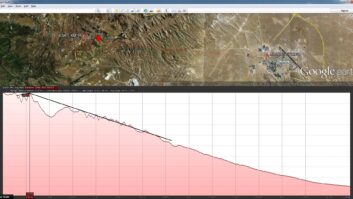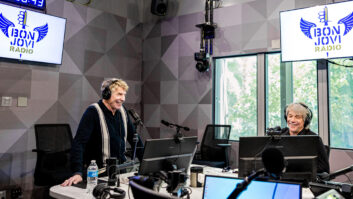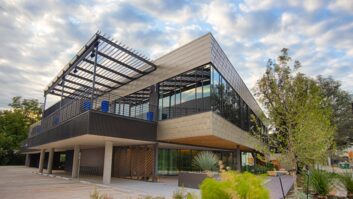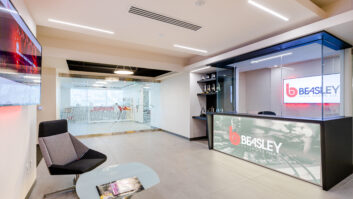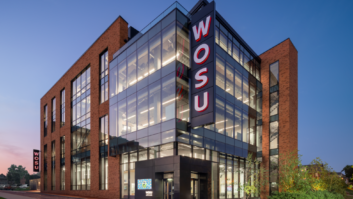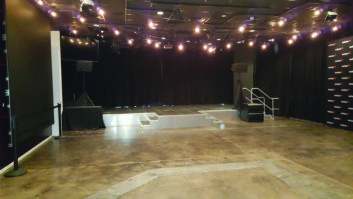
Creating space for performance studios has become a popular way to generate nontraditional revenue for stations.
Fig. 1 shows space set aside at Engineering Manager Armando Gonzales’ Entercom cluster in Dallas. Note the charging stations in Fig. 2, helpful in an age when most every listener has a smartphone. These stations are sponsored by Verizon, another plus.
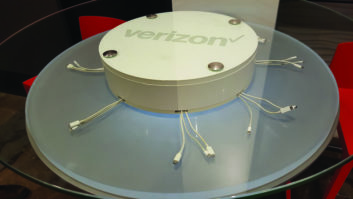
We’ve seen smart TVs with USB drive ports that play loops of station promotion videos or slides, but Armando’s reception area took this idea a step further. The 55-inch sets were mounted lengthwise (see Fig. 3) for a stunning impression for visitors.

Engineering working in conjunction with the promotions department is a definite win-win. Send us your own good examples via the email address below.
***
After several columns discussing station logs, one Workbench reader raised a question.
This engineer’s towers and lighting are owned by Vertical Bridge. The company has sophisticated gear on their lighted towers to sense problems and to notify their operations center should a failure occur.
The station does absolutely nothing with respect to checking tower lights on the towers it no longer owns but currently uses. The engineer admits he glances at the lights when he is nearby after sunset, and if there is an issue he will look for a NOTAM just because he cares about the pilots, though nothing is recorded in the station log.
The question is, “What is the engineer’s or station’s responsibility here?”
For the answer, I turned to Ed Trombley, an engineer with Munn-Reese Broadcast Engineering Consultants.
Ed responded that the question was a good one. Up in Michigan, where the firm is located, they experience their share of unstable winter weather with both freezing rain and ice. This kind of weather puts the tower light monitoring question to the test several times each winter.
Tower light monitoring from a central location is now a common practice, with many group owners setting up a central command post staffed 24/7/365. Most of this monitoring requires the internet to be up and running. Although Ed can’t speak for your wireless provider, he writes that in Michigan they seem to have the signals bounced off every farm silo, grain elevator and ham radio tower!
[Want more information like this? Subscribe to our newsletter and get it delivered right to your inbox.]
The barn storming wireless network is like the old telephone party line. Get an ice day where the school is closed, and the wireless network turns to mud! So what happens when the ice takes down Reddy Kilowatt and the wireless internet goes poof? Did the backup generator start? If it did, there is a good chance the tower lights are on. Otherwise the lights may be out, the wireless may be down, and the guy at tower light central may not know.
So in the case where a station is leasing vertical real estate on a tower where the lights are monitored from some central location, Ed directs us to part 17 of the FCC Rules:
- 17.6 Responsibility for painting and lighting compliance.
(a) The antenna structure owner is responsible for maintaining the painting and lighting in accordance with this part. However, if a licensee or permittee authorized on an antenna structure is aware that the structure is not being maintained in accordance with the specifications set forth on the Antenna Structure Registration (FCC Form 854R) or the requirements of this part, or otherwise has reason to question whether the antenna structure owner is carrying out its responsibility under this part, the licensee or permittee must take immediate steps to ensure that the antenna structure is brought into compliance and remains in compliance. The licensee must:
(1) Immediately notify the structure owner;
(2) Immediately notify the site management company (If applicable) …
***
The FCC rule goes on for several more sub-statements, but from here it is intuitively obvious to the most casual observer that if your company rents space on a tower and you observe the lights are dark, you need to call the tower owner for confirmation.
That emergency number should be posted on the gate. Ten minutes of your time may keep somebody else alive.
And as for the “automatic monitoring,” Ed shared a true story:
At breakfast with a good friend and fellow broadcast engineer, the subject of towers was discussed. Some folks at an adjacent table heard the discussion, and explained that they lived near a tall tower on a big hill in southern Michigan. They said that the tower’s lights had been out for four months. A few questions later and Ed had confirmed the tower location, and got the gentleman’s phone number. Ed told him the lights would be on by the time they got back home, about a four-hour drive.
Ed made a phone call, and three hours later, he got a return call, explaining that a failure had indeed left the tower lights dark, even though the remote control showed normal status; the lights were on and blinking.
Being vigilant with respect to tower lighting — even if it’s not your tower — may save a life. Thanks, Ed, for your insight with respect to this important matter.
Contribute to Workbench. You’ll help fellow engineers and qualify for SBE recertification credit. Send Workbench tips and high-resolution photos to [email protected].
Author John Bisset has spent 50 years in the broadcasting industry and is still learning. He handles western U.S. radio sales for the Telos Alliance. He is SBE certified and is a past recipient of the SBE’s Educator of the Year Award.








